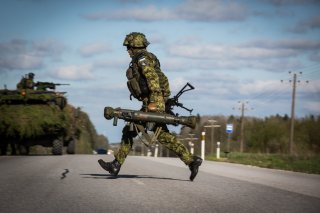Pentagon Says Western Arms Have Made a Difference in Ukraine
The Pentagon says the major weapons systems being provided, including Javelin anti-tank missiles and Stinger anti-aircraft missiles, are having a decisive impact on the war.
Since Russian military forces invaded Ukraine on February 24, they have continually stumbled in the face of stiff Ukrainian resistance that has been fortified by significant Western-supplied armaments. Now, after struggling to accomplish any of their apparent objectives, Russian forces have retreated eastward to the Donbas.
The Pentagon says the major weapons systems being provided, including Javelin anti-tank missiles and Stinger anti-aircraft missiles, are having a decisive impact on the war.
“I would just offer you a look, we're at two months into this war. And Mr. Putin didn't take Kyiv. He didn't take Chernihiv. He hasn't taken Odessa. And instead of moving on three, why geographically separated lines of axes, now he's concentrating all his firing and forces in the East and in the south,” Pentagon spokesman John Kirby told reporters, according to a transcript.
The initial round of weapons, such as shoulder-fired anti-tank weapons, anti-aircraft systems, and millions of rounds of ammunition, demonstrated a near-immediate impact, as Ukrainian forces were able to conduct hit-and-run, asymmetrical ambushes on Russian armored vehicle convoys. By using the terrain and buildings to their advantage, Ukrainian fighters have also appeared to have success destroying Russian helicopters with shoulder-fired Stinger missiles. Foreign drones have also had an impact, along with small arms.
However, more recently there has been an influx of heavier systems just in time for Russia’s military consolidation and refocus on the Donbas to the east. This is an area where heavier weapons might be of even greater value to the Ukrainians, who now have U.S. 155mm Howitzer artillery systems, advanced air defenses, armored personnel carriers, and German tank-like anti-aircraft guns called Cheetahs, among other things.
These heavier systems could create significant pain for Russia, which is reported to have repositioned, resupplied, and rearmed much of its remaining heavy force for the purpose of launching a massive offensive into Donbas. Ukrainian artillery will be able to launch suppressive fire onto approaching Russian troops, dispersing attacking troop concentrations, convoys, and static missile launchers from more than 30km away—a capability that the Ukrainians have not had thus far.
Armored personnel carriers will also allow Ukraine to quickly reinforce dismounted units in urban combat and add speed and concentrated power to close-quarter combat. The U.S. Defense Department’s list of equipment also includes counter mortar and counter artillery radar systems which will make a difference in stopping Russia’s shelling and rocket attacks into civilian areas. These kinds of radar, working in tandem with drones and other supportive surveillance technologies, can help identify the launch points of many of Russia’s inbound ballistic missiles. Finding and destroying those launchers could prove pivotal in this war as Russia has based its attack strategy upon indiscriminate bombing and destruction of civilian areas.
“[Putin] has achieved none of his strategic objectives. So, I think that's proof right there that the kinds of systems that are being provided to Ukraine have had … an effect on their self-defense needs,” Kirby said.
Kris Osborn is the Defense Editor for the National Interest. Osborn previously served at the Pentagon as a Highly Qualified Expert with the Office of the Assistant Secretary of the Army—Acquisition, Logistics & Technology. Osborn has also worked as an anchor and on-air military specialist at national TV networks. He has appeared as a guest military expert on Fox News, MSNBC, The Military Channel, and The History Channel. He also has a Master’s Degree in Comparative Literature from Columbia University.
Image: Flickr.

